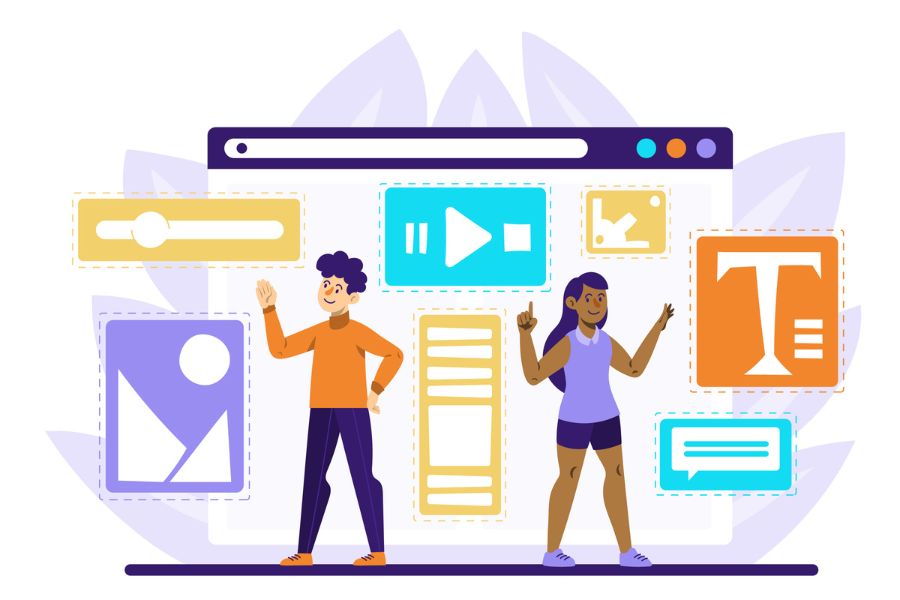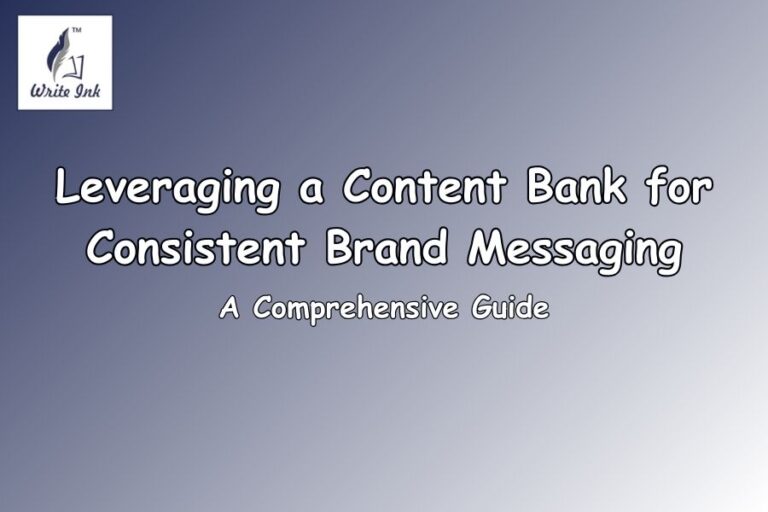Elevating Brand Presence: A Comprehensive Guide to Website Content Writing & Management
Google receives 8.5 billion searches every day, and many of the searchers click the very first link. So, what are they clicking on? It is what we call website content.
Website content is the content you find on different websites. It is through this content that brands communicate with their audience. Your website content is not just words on a page, it’s your brand’s voice. It plays a crucial role in building your brand’s image. If you provide the right content, it could turn visitors into potential customers. So, it’s important to know what to communicate to your audience through your website content. Your website needs to provide more than just basic information. It needs diverse, clear, adequate, dynamic, and search engine-optimised (SEO) website content.
Since you now have a basic idea as to what website content is, we will discuss it in more detail below, along with other topics like website content management, how to write good content for a website, which content is the best for a website, why is content important in a website, what is SEO website content, how to present a case study on website and a sample content analysis case study.
What Is Website Content Writing?

Any content that you read on a website is termed website content (including this article that you are reading). Website content writing is the process of writing, editing, and publishing content digitally on a website for the sake of engaging with the audience. But “website content” as a term covers a lot of things, so let’s unpack that first. Let’s look at the types of website content that are generally found on a website:
Website Copy: This is the basic information that is needed in order to learn about a business and appears on pages like the homepage, landing page, about page, FAQ page, or contact us page. The website copy explains your brand and guides the readers throughout their tour of the website.
E-books: Many businesses offer e-books to their customers, allowing them to learn about their services in detail. For example, a university website provides a prospectus giving details about its campus and facilities. Companies also offer free resources to attract customers.
Case Studies: Brands can use case studies to illustrate the success of their products by writing about how their product helped a client. These case studies provide customers’ data and help build trust.
Blog Posts: No longer just personal blogs about your feelings, blog writing is now an essential component of a website’s content marketing strategy. Blog posts are usually to the point and written to attract, educate, and delight readers. They are also used to keep the audience informed of new developments within the company. SEO blogs and SEO website content draw a large number of visitors. For example, Byju’s, a coaching institute, provides free study material through blogs.
Product Category Descriptions: The product descriptions available on shopping sites are also a kind of website content that is specific yet provides all the necessary information.
Other Content: In addition to written content, brands include audio-visual elements for the audience to interact with. This may consist of videos, tutorials, infographics, photos, podcasts, etc.
What Is Website Content Management?

We mentioned earlier that website content writing is the process of writing, editing, and publishing content digitally on a website. So, the management of this whole process is termed website content management. It is an umbrella term covering ideation, production, organisation, editing, and publication of content.
Those in charge of website content management decide on the topics of the content according to the brand’s marketing strategy, decide on the tools required for content production (like Canva, Unsplash, etc.), organise the content with a proper balance of text, videos, audios, and images, consider the budget and human resources needed to produce the content and select the SEO tools required to optimise search results. The main goal of content management is to ensure that the website delivers relevant, explicit, diverse, adequate, and impressive content to its viewers and that the content pours in consistently while adhering to brand strategy.
How To Write Good Content for A Website?

Below is a website content guide that will probably help you write good content for your website:
1. Keep in mind your target audience: Before drafting your content, you need to ask yourself: “Who is my target audience?” For example, if you are making a coaching website, your audience would mostly be students or parents. So, your content needs to be interesting to them. You can think about the kind of questions they may want answered or the topics they might be interested in knowing about and can produce content accordingly. You can also think of the terms your audience might search on Google and use those words in your headlines and subheads.
2. Research your competitors’ content: It’s a good idea to see what type of content they are publishing. This will help you identify gaps in your strategy, fill the gaps left by the competitors’ content, generate new ideas, and understand what resonates with your target audience. You can look at the kind of content they are publishing (listicles, short blogs, how-to guides, videos, etc.), the topics they are choosing, or how engaging their content is.
3. Write unique content: Readers won’t visit your page if they can find similar information elsewhere. Try to make your content stand out by using new sentences, examples, or tips. Research a wide range of sources for content ideas.
4. Get the reader hooked from the first line: Just like a good book pulls you right in from the start, your web content should catch your readers’ attention so that they don’t quit the page. Use some bold statements to spark interest.
5. Follow the “inverted pyramid” model: Web readers have very short attention spans. They want the required information at the beginning of any article. So, write your article like an upside-down pyramid where the most important messages go at the top, and it narrows down below with less necessary points.
6. Make your content scannable: Most readers scan, rather than read, online content and look for information on specific topics. So, to make scanning easy, include subheadings, short sentences, and white spaces in between paragraphs. I prefer using bulleted lists instead of text-heavy paragraphs. Subheadings not only help readers but also help search engines find your content.
7. Write conversationally and use comprehensible language: Talk to readers like you would to a friend. This conversational manner is easy to understand and feels more personal. Use “you” for the reader and “we” for the brand. Keep the language simple so the readers don’t get frustrated, and provide examples to help them digest high-level concepts.
8. Fill every sentence with value, using quotes: Only add those sentences that give new information to the reader. Do not add extra words, or you may lose your reader. Add quotes by the experts in the field you are concerned with. This will make for a well-rounded argument.
9. Incorporate multimedia: Adding audiovisual elements (like images, videos, infographics, etc.) helps people better understand, remember, and engage with the content. An infographic makes a complex process look easier, while a video demonstrates how a product works in a way that is more engaging than text. Images break up the text, making reading easier.
10. Edit and proofread: After finishing writing, return to your content to check for errors. Good writing is not possible without thorough editing, and erroneous content will undermine the reader’s trust in your brand.
11. Embed links: By embedding links in your web content, you can direct readers from one page to another (especially those on your website). It’s a great way to lead readers to even more information. For example, if your website showcases your writing portfolio, you can provide links to your published works, certificates, books, etc.
12. Regularly update content: The information on the internet is constantly updating and changing. So keep updating your website content so that it reflects the latest information.
Which Content Is Best for A Website?

Best website content is one which has been written according to the above mentioned points, fulfils the website content requirements, and has been optimised for search engines. Search engine optimisation (SEO) brings traffic to your website by ranking your website on top in the search results. We will discuss SEO website content below.
For example, there is a website, Chill Subs, which provides resources for writers. Their SEO website content is working best for them. They have tailored their content keeping in mind their target audience (writers and editors) and have come up with unique services for writers which no other website in the industry has done. They provide publication opportunities to writers by releasing lists of all kinds of magazines where writers can submit and have a database of freelance writers, editors, etc., from where people can avail their services.
They also organise workshops and more. They use a catchy phrase on the homepage to hook the visitors, they make use of multimedia, their website is free from grammatical errors, they have personalised fonts, colour combinations, and logos, and their website is regularly updated. They have established their brand and following over a short time.
Why Is Content Important in A Website?

- Content is the only way to send your brand, product, or service across to customers looking for solutions to a problem that your product can solve.
- Content is essential to add value to your site. Valuable, educational content makes it easy for old or new customers to find the information they need. If your website is content-rich and worthwhile, they will keep returning to it.
- Good SEO website content will rank higher in search results and, hence, bring traffic to your website. Google is more likely to rank sites with regularly updated content. Many people use the Internet for research, so getting your SEO website content right means getting your content in front of them.
What Is SEO Website Content?

“SEO” stands for Search Engine Optimisation, that is, the process of optimising a website or website content to rank high in search results so that people can easily find it via search engines.
Search engine optimised (SEO) website content is made with the goal of ranking high in search results and thus attracting traffic. Hence, content is the key. Some things that you’ll need to make your website content SEO website content:
- Research the most-searched words or keywords on search engines and write towards those topics about which people are searching the most for information.
- Know how and where to use keywords in your content for maximum visibility. Use important terms in headings and subheads.
- Augment visibility of new content by sharing on social media.
- Regularly publish content on your website because it receives more traffic than less frequently updated websites.
How To Present a Case Study On A Website?

While presenting a case study on your website, keep in mind the following points:
- Depending on your brand, choose a format to display your case study. It could be text, infographic, video, audio, graph, etc.
- Highlight the problem that your customer faced and the solution that your product provided.
- Include customer testimonials to build trust in your brand.
- Include SEO Keywords in your case study to make it reach a wider audience. While writing SEO Website Content, Case Studies are often left out. Do not make this mistake.
- Promote your case study on social media.
- Make your case study actionable by including a call to action to invite your audience to ask a question, call, or subscribe.
Content Analysis Case Study (Write Ink Case Study)
Content Analysis Case Study: Anita’s Aromatics Website
Client Background:
Anita’s Aromatics is an Indian brand specialising in natural and luxurious aromatherapy products. Their range includes essential oils, skincare products, and wellness accessories, all crafted with a focus on purity, quality, and sustainability. With a solid commitment to holistic well-being, Anita’s Aromatics aims to promote wellness and self-care practices rooted in ancient Indian traditions.
Client Goals:
- Enhance brand presence and visibility online.
- Showcase the unique features and benefits of Anita’s Aromatics products.
- Educate and engage customers about aromatherapy and its benefits.
- Drive website traffic and increase online sales.
Content Strategy:
Write Ink collaborated with Anita’s Aromatics to develop a comprehensive content strategy tailored to their brand identity and target audience. The strategy encompassed the following key elements:
- Research and Analysis: Write Ink conducted in-depth research on aromatherapy, natural skincare, and wellness trends to gain insights into the target market’s preferences and interests. This analysis informed the content direction and messaging strategy.
- Brand Voice and Tone: A warm, inviting, and knowledgeable tone was established to reflect Anita’s Aromatics’ commitment to holistic wellness and expertise in aromatherapy. The content aimed to evoke a sense of tranquillity and authenticity while conveying the brand’s values and mission.
- Content Creation: Write Ink developed a variety of content types to cater to different stages of the customer journey, including:
Homepage: This is a captivating introduction to Anita’s Aromatics, highlighting its core values, product offerings, and unique selling points.
Product Pages: These provide detailed descriptions of each product, emphasizing its natural ingredients, benefits, and usage instructions.
Blog Articles: Informative and engaging articles on topics such as the benefits of essential oils, skincare tips, aromatherapy techniques, and wellness rituals.
About Us Page: A compelling narrative detailing Anita’s Aromatics’ story, mission, and commitment to sustainability and quality.
FAQ Section: Answers to commonly asked questions about aromatherapy, product usage, and ingredient sourcing.
SEO Optimisation:
The content was optimised with relevant keywords and meta tags to improve search engine visibility and attract organic traffic.
Visual Content Integration:
High-quality images and graphics were incorporated throughout the website to enhance visual appeal and showcase the beauty of Anita’s Aromatics products.
Results
The implementation of the content strategy resulted in significant improvements in Anita’s Aromatics’ online presence and performance:
Increased Website Traffic: The engaging and informative content attracted a larger audience to the website, resulting in a notable increase in traffic and user engagement metrics.
Improved Brand Awareness: The consistent and compelling messaging helped to elevate Anita’s Aromatics’ brand awareness and recognition within the aromatherapy and wellness community.
Enhanced User Experience: The user-friendly navigation and informative content provided visitors with a seamless and enjoyable browsing experience, leading to higher customer satisfaction and retention rates.
Higher Conversion Rates: The informative product descriptions and persuasive storytelling contributed to an uptick in conversions, with more visitors making purchases and becoming repeat customers.
Parting Wisdom

Through a strategic and tailored approach to content creation, Write Ink successfully elevated Anita’s Aromatics’ online presence, effectively engaging its target audience and driving meaningful results. By leveraging compelling storytelling, expert insights, and SEO best practices, Anita’s Aromatics established itself as a trusted authority in the field of aromatherapy and holistic wellness, ultimately contributing to the brand’s growth and success.
Content management by Vaimo. https://www.vaimo.com/expertise/content-management/
FAQs: Frequently Asked Questions
Q: What is website content writing?
A: Website content writing involves crafting, editing, and publishing digital content on a website to engage with the audience effectively.
Q: What are the types of website content?
A: Website content includes website copy, e-books, case studies, blog posts, product category descriptions, and other multimedia elements like videos, infographics, and photos.
Q: Why is content management important for a website?
A: Content management ensures the production, organization, and publication of relevant, diverse, and impressive content, aligning with the brand’s strategy and engaging the audience consistently.
Q: How can I write good content for a website?
A: Writing good website content involves understanding the target audience, researching competitors’ content, writing unique and engaging content, optimizing for search engines, and regularly updating the content.
Image Reference: Freepik
Disclaimer: All trademarks, logos, and brand names are the property of their respective owners. All company, product, and service names used in this website are for identification purposes only. Use of these names, trademarks, and brands does not imply endorsement.







